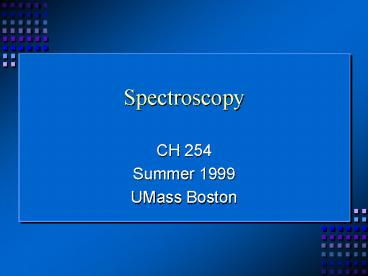Spectroscopy - PowerPoint PPT Presentation
1 / 27
Title:
Spectroscopy
Description:
Energy absorption corresponds to transitions between fixed energy levels. ... Different regions of electromagnetic spectrum have different types of ... – PowerPoint PPT presentation
Number of Views:100
Avg rating:5.0/5.0
Title: Spectroscopy
1
Spectroscopy
- CH 254
- Summer 1999
- UMass Boston
2
Structural Information
- Chemical methods
- functional group tests
- chemical transformations
- Physical measurements
- physical properties
- spectroscopy
3
Molecules Energy
- Energy absorption corresponds to transitions
between fixed energy levels. - Absorption of energy can be monitored by
spectrometers. - Tracings obtained are called spectra.
4
Types of Spectroscopy
- Different regions of electromagnetic spectrum
have different types of spectroscopy associated
with them. - Fundamental equation
- E hn hc/l
5
The Electromagnetic Spectrum
- Wide range of energy
- cosmic rays to radiowaves
- Online table of the electromagnetic spectrum.
6
Types of Spectroscopy in CH 254
- UV-visible spectroscopy
- IR spectroscopy
- NMR spectroscopy
7
UV-Visible Spectroscopy
8
Instrumentation
9
Functional Groups and UV-Vis
10
What is UV-Vis Good For?
- Detecting the presence of distinctive groupings
of atoms (chromophores). - These are usually conjugated systems.
- The more conjugation, the longer the wavelength
of the absorption. - Added substituents (electron donors or
withdrawers) alter the wavelength.
11
Examples
- 1,3-pentadiene lmax 224 nm
- 2,5-dimethyl-2,4-hexadiene lmax 243 nm
- b-carotene lmax 425, 450, 477 nm
12
Color Wheel
13
IR Spectroscopy
- Atoms in a molecule are constantly in motion
(stretch, bend, etc.) - Energy levels correspond to vibrational states.
- Spacing between these states is on the order of
3-30 microns. - Use frequency units for IR 400-4000 cm-1 (1 cm-1
10,000/microns)
14
IR Interactions
- Frequency required depends on
- mass of bonded atoms (lighter atoms vibrate at
higher frequencies) - stiffness of bond (stiffer bonds vibrate at
higher frequencies) - Functional groups have characteristic stretching
frequencies (see handout).
15
Hydrocarbons
- C-H stretch (2800-3300 cm-1)
- Hybridization of carbon affects position
- alkanes (sp3) 2800-3000 cm-1
- alkenes (sp2) 3000-3100 cm-1
- alkynes (sp) 3300 cm-1
16
Alkanes and Alkenes
17
Alkynes and Nitriles
18
Alcohols
19
Amines
20
Ethers
21
Carbonyl Compounds
- CO stretch is very distinctive.
- Many functional groups contain this substructure.
- Supplementary bands are needed to help
distinguish the functional group.
22
Ketones
23
Aldehydes
24
Carboxylic Acids
25
Esters
26
Hints for IR
- Work from left to right - look for the major
absorptions first. - Useful checkpoints
- 3500 (OH, NH)
- 3000 (is there unsaturation present?)
- 2200 (is there a triple bond?)
- 1700 (is there a carbonyl?)
- 1200 (is there a C-O?)
27
More Hints
- Use common sense!
- Look at the molecular formula - if there isnt
any nitrogen, dont look for NH or CN groups. - The SODAR calculation is useful - if SODAR is
zero, there wont be a carbonyl, for instance.































